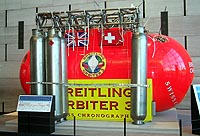
92k JPEG
Smithsonian Institution
photograph #1999WB0007
|
Milestone:
First Nonstop Flight Around The World by Balloon |
Date of Milestone:
March 21, 1999 |
Vehicle:
Breitling Orbiter 3 Gondola |
Manufacturer:
Cameron Balloons, Bristol, England, 1998
|
Artifact Location:
Smithsonian Institution, National Air and Space Museum, Milestones
of Flight Gallery |
On March 1, 1999, Bertrand Piccard and Brian
Jones lifted off from the Swiss alpine village of Chateau d’Oex
in the Breitling Orbiter 3 balloon. On March 21, 1999—19 days, 21
hours, and 55 minutes later—they landed in the Egyptian desert after
traveling 45,755 kilometers (28,431 miles) and completing the first
nonstop flight around the world in a balloon.
The success of Breitling Orbiter 3 was built
upon two previous attempts: Breitling Orbiter in 1997 and Breitling
Orbiter 2 in 1998. Those experiences enabled the Breitling team
to develop trustworthy technical systems and a basic strategy in
which Piccard and Jones would pilot their balloon up to altitudes
of 11,000 meters (36,000 feet) and to where jet stream winds would
drive it across the Pacific at up to 176 kilometers (105 miles)
per hour.
Support for this exhibit was provided by Breitling SA and Federal
Express Corporation.
Design Features:
Construction: The gondola is made of Kevlar and carbon fiber
material.
Cabin air: After takeoff the gondola was pressurized with
a nitrogen-oxygen mixture to reduce the risk of fire. Enough reserves
were carried to repressurize the gondola four times.
Pressurization: Cabin pressure dropped as the balloon climbed.
At 10,000 meters (33,000 feet), the cabin pressure equaled the atmospheric
pressure at 3,000 meters (10,000 feet).
Temperature: Burners maintained the cabin temperature at
15 °C (59 °F).
Solar panels: Solar panels beneath the gondola recharged
the onboard lead batteries that provided electrical power.
Instrumentation: The forward cockpit contains the controls
and instruments needed to monitor and operate the aircraft and systems.
The crew used satellite-based systems to communicate and navigate.
Accommodations: The central part of the cabin contains a
single bunk and storage area. An ingenious pressure-operated toilet
is screened off with a curtain at the rear of the craft.
Gondola:
| Length: |
5.4 m (17 ft 10 in) |
| Height: |
3.1 m (10 ft 3 in) |
| Weight, empty: |
2,000 kg (4,400 lb) |
| Fuel: |
Propane |
| Manufacturer: |
Cameron Balloons, Bristol, England, 1998 |
|
![]()
![]()
